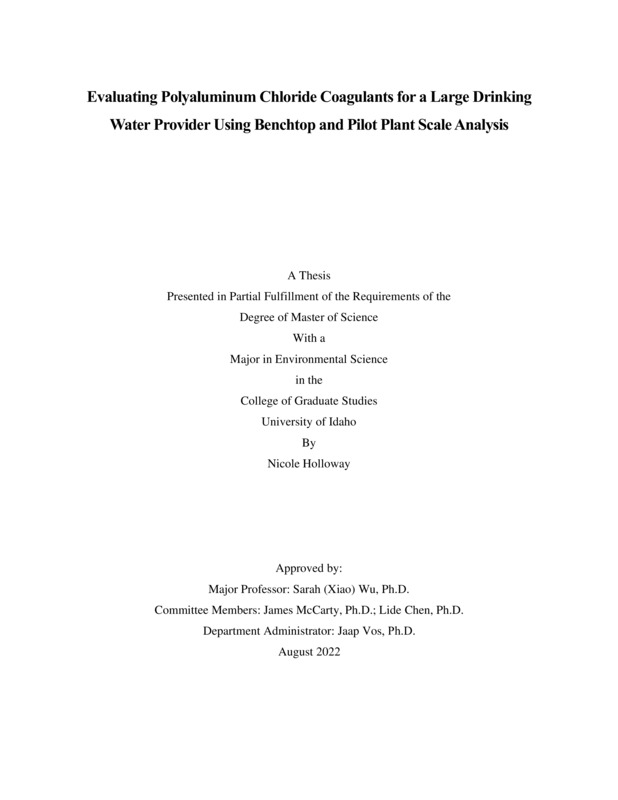Evaluating Polyaluminum Chloride Coagulants for a Large Drinking Water Provider Using Benchtop and Pilot Plant Scale Analysis
Holloway, Nicole. (2022-08). Evaluating Polyaluminum Chloride Coagulants for a Large Drinking Water Provider Using Benchtop and Pilot Plant Scale Analysis. Theses and Dissertations Collection, University of Idaho Library Digital Collections. https://www.lib.uidaho.edu/digital/etd/items/holloway_idaho_0089n_12441.html
- Title:
- Evaluating Polyaluminum Chloride Coagulants for a Large Drinking Water Provider Using Benchtop and Pilot Plant Scale Analysis
- Author:
- Holloway, Nicole
- ORCID:
- 0000-0003-3518-4885
- Date:
- 2022-08
- Keywords:
- Beaver Water District Coagulation Drinking Water Jar Test Polyaluminum Chloride Water Treatment
- Program:
- Environmental Science
- Subject Category:
- Water resources management; Bioengineering; Chemical engineering
- Abstract:
-
In this study, polyaluminum chloride (PACl) coagulants were evaluated for use at a surface water treatment facility in that currently uses aluminum sulfate (alum). The coagulants were evaluated using a triple bottom line approach incorporating publich health, fiancial viability, and environmental impact in three phases. In phase 1, jar tests were utilized determine two high performing PACls out of 8 to move forward into phase 2 based on treatment efficiency in comparison each other and to alum. One of the top performing PACl coagulants was evaluated to determine the treatment factors that are significant to turbidity removal via jar testing utilizing a central composite design (CCD). In phase 2, the selected PACl coagulants were evaluated at the pilot plant scale. The data from phase 2 was utilized in the triple bottom line analysis. Finally, in phase 3, financial analysis and sludge production of PACls was conducted and compared with Alum to evaluate the environtmental impact and financial viability. The research concluded the PACl coagulants performed as well or better than alum at meeting clean and safe drinking water treatment criteria. Alum, PACl 1, and PACl 2 had a similar disinfeciton by product formation potential with negligable difference in THM production. Both PACls performed better in removing TOC and DOC consistently above the EPA guideline of 25% through the pilot plant runs with 28-42% and 30-40% for PACl 1 and PACl 2 respectively and 19-42% for alum. PACl coagulants displayed an increased percentage of turbidity removal per mg/L of coagulant added. During the pilot trail, alum exhibited 1.88-2.23% turbidity removal per mg/L coagulant added while PACl 1 and PACl2 exhibited 4.35-5.64% and 3.86-4.85% respectively. The PACl coagulants were not as financially feasible as alum based on the pilot plant data. PACl treatment trains in pilot runs retained alkalinity and thus reduced lime feed and had zero caustic feed. Sludge production was reduced in PACl treatment. These reductions were not enough to offset the increased chemical cost of PACl to alum with PACl 1 being $402,203 and PACl 2 being $652,100 higher than alum annualized and extrapolated based on 2018 production data. The reduction of chemical additions and sludge prodcution made the PACl coagulants more environmental friendly. The CCD examination validated that raw water pH and coagulant dosages are the significant variables to both settled and filtered turbidity removal when using polyaluminum chloride coagulants on water from Beaver Lake. The study produced significant model equations to determine values for these variables to achieve optimal treatment.
- Description:
- masters, M.S., Environmental Science -- University of Idaho - College of Graduate Studies, 2022-08
- Major Professor:
- Wu, Sarah
- Committee:
- McCarty, James; Chen, Lide; Vos, Jaap
- Defense Date:
- 2022-08
- Identifier:
- Holloway_idaho_0089N_12441
- Type:
- Text
- Format Original:
- Format:
- application/pdf
- Rights:
- In Copyright - Educational Use Permitted. For more information, please contact University of Idaho Library Special Collections and Archives Department at libspec@uidaho.edu.
- Standardized Rights:
- http://rightsstatements.org/vocab/InC-EDU/1.0/

